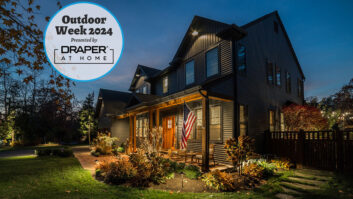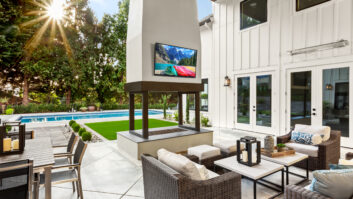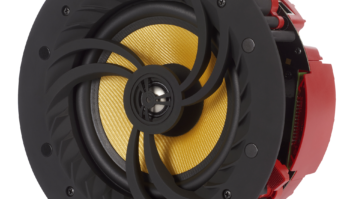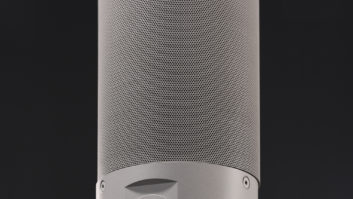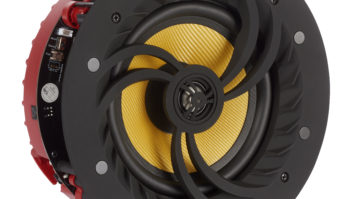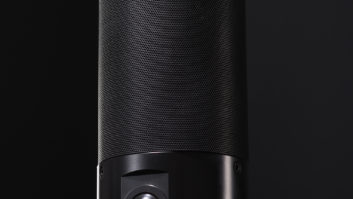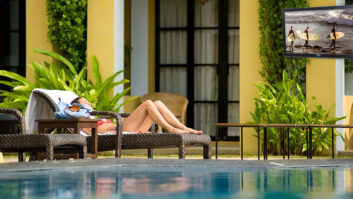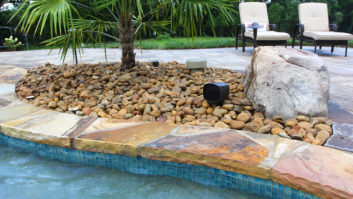The latest space being wired for stereo music isn’t inside, it’s outdoors–in the garden, on the deck or patio, at poolside, among the foundation plants and amidst the flower beds. It might even add a whole new meaning to the term rock garden, and it’s a great opportunity to up-sell your customers by enhancing their commercial and residential waterscapes with sound.
Most people don’t realize that getting great sound in the great outdoors can be more difficult than in a family room or home theater. First off, you need equipment that performs well and withstands a harsh environment. And where interior rooms actually help contain and shape sound, outdoor areas seem to swallow it up, making music sound soft, hollow or
unnatural sounding.
For creating great outdoor “soundscapes,” there are basic guidelines to follow that will help installation professionals and homeowners choose the type, quantity and placement for outdoor speakers.
–Be heard without being seen. High-fidelity loudspeakers can be found in enclosures designed as rocks, pedestals, flowerpots and other outdoor fixtures or natural elements. It is now possible to enjoy music outdoors without ever seeing where the sound comes from. For those less concerned about camouflaging their music source, specially designed in-ceiling, in-wall and on-wall mounting systems allows speakers to be placed inconspicuously in a variety of locations.
–Check that the weather resistance of the speakers-and the enclosure containing it-will more than withstand the climate where they are being installed. Harsh sun can be as damaging as bitter cold or heavy rain. Saltwater is more troublesome than moisture alone. Finally, make sure you get a warranty that covers the speaker electronics as well as the housing.
–Get speakers with high-power handling-at least 50 watts. Sound dissipates more readily outdoors, and you may need to play music at a higher level to get acceptable volume across the listening area. This is especially true when there are waterfalls or other waterscapes where running water can drown out the music.
–Outdoor speakers can be designed to deliver sound in a directional or omnidirectional pattern. Choose the speaker that best suits the application. For example, an omnidirectional speaker would work well on a patio or other place where people could be anywhere around the speaker. A directional speaker would be recommended for use near foundation plantings, or placed near or against a wall or fence.
–Should you use two speakers for stereo or one? Conventional stereo sound is created with separate left and right speakers where each speaker provides a distinct audio channel. With the correct placement, they recreate the dimensional sound “image” of a live performance. An outdoor setting may not lend itself to conventional left/right speaker placement or provide a suitable situation for recreating the stereo image that you get indoors. To address this, consider high-fidelity outdoor speakers with either single-channel or stereo input. Stereo input allows both left and right channels to come through the same speaker. Along a walkway, for example, stereo-input speakers create an even sound, where a conventional left-right configuration wouldn’t sound right. In a small space, a single omnidirectional stereo-input speaker might be all that is needed to enjoy music outdoors.
–How much distance should you have between speakers? It depends on the space and the speakers, but a useful guideline is from six to 15 feet. Listen, however, to how they sound before mounting them in place or finally burying cables. Too much distance often results in loud and quiet spots in the sound field or failure to get a good stereo effect. Too little distance is simply a waste of money for the consumer.
–Do you need to install more than two speakers? If you are providing sound to a large area, such as in a large commercial installation, you may need more than two speakers to cover the area adequately. You may even have the desire to offer different music in different areas. In cases like this, you will want to investigate using a multi-zone system, which allows you to distribute audio-either from the same audio source or a different one-to more than one area at the same time. For example, you can have pop music playing out by the pool, while the news or a jazz station is playing on the patio or indoors. Or, you can have the same music playing in two or three different areas simultaneously. With this setup, a stroll through a Japanese garden can be enhanced with music all the way through.
–When placing speakers away from the house, use burial speaker cable and weather-resistant wire connectors. Cable that’s made to run underground has a tough outer housing and internal stranding for greater strength to provide decades of trouble-free use. Look for outdoor speakers that include burial wire as well as weather-resistant connectors. If you’re creating a soundscape for commercial use, you may need to run the wire through conduit, so make sure that you check your building code.
–How do you control your audio source and volume. If you’re designing audio for a backyard or entertainment environment, you will want to provide control of both music selection and volume without the need to run inside to change volume level, etc.. Within a protected area or a weatherproof enclosure where in-wall controls can be placed, you can install controls similar to those you might use indoors. These can be used in combination with hand-held remote controls, just like you would use indoors. If you don’t have outdoor controls, there are remotes that can transmit signals through walls, offering your customers the convenience of not even needing to get out of their hammocks.
–Installation. For any professional audio installer, placing speakers, running/burying speaker cable and connecting it to your audio receiver is a simple task, even if it means drilling through a wall to run the speaker wires inside. If you are just getting started in this business, then contact CEDIA for more advice.
Scott Sylvester is the director of technical services for Sonance (www.sonance.com) in San Clemente, California.
